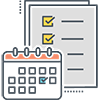
9 Critical Path Method Advantages
 The Critical Path Method (CPM) enables you to establish a critical path for your project and diagram main tasks as well as dependencies using a network analysis approach. It makes scheduling, allocating resources, and completing tasks easier.
The Critical Path Method (CPM) enables you to establish a critical path for your project and diagram main tasks as well as dependencies using a network analysis approach. It makes scheduling, allocating resources, and completing tasks easier.
Project managers around the world use this method across industries to bring projects to completion within a given deadline and optimize costs.
In this article, we’ll take a closer look at the main Critical Path Method advantages to help you understand what you can gain from adopting it.
Critical Path Method Advantages & Benefits
 So, how exactly can this approach to project management help you? We will assume that you are a project manager looking to complete a medium or big project.
So, how exactly can this approach to project management help you? We will assume that you are a project manager looking to complete a medium or big project.
- Helps Identify Key Project Tasks – The Critical Path Method encourages you to differentiate between critical and dependent activities and prioritize them accordingly. Sometimes, tasks that you may not think are important are essential to completing the project and require more resources than initially thought. With CPM, you can identify them early on and bring them to the attention of the whole team.
- Encourages You to Run Activities in Parallel – The network analysis approach of CPM enables you to figure out which dependent tasks your team can work on in parallel to speed up goal completion.
- Determines Project Duration Accurately – By establishing a critical path and diagraming dependent tasks, CPM makes it easier for you to determine the duration of the project before any work begins. This is because it requires you to carefully consider the time duration for each phase as well as for dependent tasks.
- Allows for the Easy Visualization of Tasks – One of the key aspects of CPM is the network diagram that you draw including main tasks as well as dependencies. More than a useful organizational tool, the network diagram can be shared with your team to show them the backbone of the project at a glance and differentiate between critical and non-critical tasks.
- Makes Documenting the Project Easier – Another benefit of CPM is that it provides a succinct way to document a project every step of the way. It can help you reference tasks and understand who did what and when without getting bogged down in paperwork or having to keep extensive logs for each activity in turn.
- Simplifies Task Assignment for Individuals – CPM establishes dependent tasks early on, and that can make it easier for you to assign tasks to individual members of your team in a way that best fits their skills. This can be an especially important advantage for large projects requiring a lot of small tasks.
- Helps You Determine How Much Your Team Can Slack – CPM makes you think about the Slack time—the maximum amount of time you can delay an activity without compromising the project. Considering slack time early on could help you manage stress and delay non-essential tasks without delaying the entire project even if you’re up against a rather tight deadline.
- Enables for Clear Communication – Whether you are reporting to a boss, a board of directors, or to business partners, CPM makes it possible for you to explain the schedule and cost performance of your project in a simple way.
People do not need theoretical experience in project management to understand a CPM network diagram or presentation. - Wide Adoption – CPM is widely known in the world of project management, so it’s reasonable to assume that team members, partners, and others are comfortable with it.
Critical Path Method Advantages – The Bottom Line
As you can see, the Critical Path Method comes with plenty of advantages that could benefit your organization. Whether you’ve used this method before or are thinking about adopting it, trying it out for at least one project can be an inspired decision. It can help you better plan projects and focus on the critical activities you need to complete them successfully.
